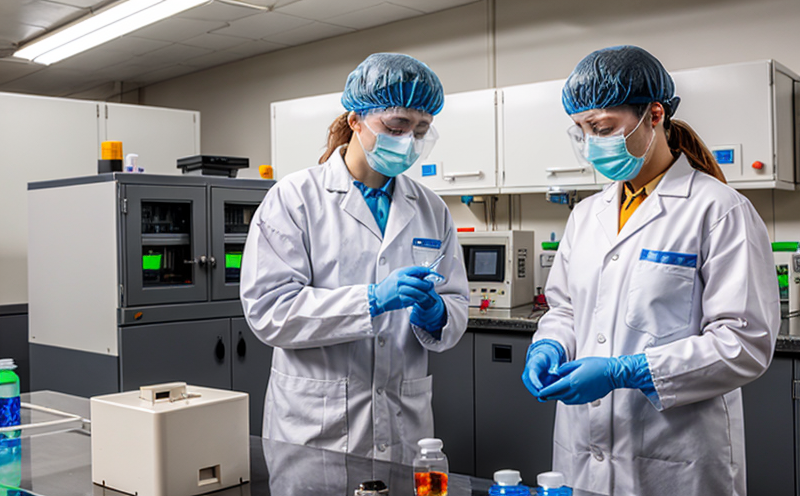ISO 57408 Acrylamide Testing in Baby Cereals
The safety of food products, especially those intended for infants and young children like baby cereals, has become a critical issue in recent years. One of the emerging concerns is acrylamide, a potentially harmful chemical compound that can form during high-temperature cooking processes such as frying, baking, or roasting. ISO 57408 specifically addresses the testing methodology for detecting and quantifying acrylamide content in baby cereals.
Acrylamide has been classified by the International Agency for Research on Cancer (IARC) as a Group 2A carcinogen, meaning it is probably carcinogenic to humans. Given this classification, regulatory bodies like the European Food Safety Authority (EFSA), the United States Food and Drug Administration (FDA), and others have set guidelines aimed at minimizing acrylamide levels in food products.
ISO 57408 provides a standardized approach for determining the concentration of acrylamide in baby cereals. This method is crucial not only because it helps manufacturers comply with regulatory requirements but also because it ensures that consumers, particularly parents, can have confidence in the safety of their children's food.
The testing process involves several steps including sample preparation, extraction, purification, and quantification using high-performance liquid chromatography (HPLC) coupled with mass spectrometry (MS). These techniques offer high sensitivity and selectivity necessary for detecting trace amounts of acrylamide. The method described in ISO 57408 ensures accurate results that can be relied upon by regulatory agencies, food safety experts, and the public.
The significance of this test extends beyond ensuring compliance with regulations; it plays a vital role in safeguarding public health. By adhering to these standards, manufacturers demonstrate their commitment to producing safe and quality products. This not only protects consumers but also enhances brand reputation and trustworthiness.
- Compliance Assurance: Ensures adherence to international safety guidelines set by organizations like EFSA, FDA, and others.
- Risk Mitigation: Reduces the risk of health hazards associated with high acrylamide levels in baby cereals.
- Informed Decision-Making: Provides critical data to help manufacturers make informed decisions about raw materials and processing methods.
The implementation of ISO 57408 testing is a collaborative effort involving multiple stakeholders including food producers, regulatory bodies, and independent laboratories. By working together, these entities can ensure that baby cereals meet the highest standards of safety and quality.
Why Choose This Test
Choosing ISO 57408 acrylamide testing in baby cereals offers numerous advantages to food processors and manufacturers. Firstly, it ensures strict adherence to international safety standards, thereby protecting public health and maintaining consumer trust.
- Regulatory Compliance: Ensures that products meet the stringent requirements set by regulatory bodies such as EFSA, FDA, and others.
- Risk Minimization: Reduces the risk of health hazards associated with acrylamide exposure.
- Informed Decision-Making: Provides critical data to help manufacturers make informed decisions about raw materials and processing methods.
The benefits extend beyond mere compliance. By choosing this test, food processors can enhance their reputation for producing safe and quality products. This not only protects consumers but also strengthens brand loyalty and market competitiveness.
Furthermore, regular testing using ISO 57408 ensures that the acrylamide levels in baby cereals remain consistently low over time. This consistency is crucial for maintaining public confidence and ensuring regulatory compliance across different batches of products.
Customer Impact and Satisfaction
The impact of ISO 57408 acrylamide testing on customers cannot be overstated. For parents and caregivers, the assurance that their children's food meets strict safety standards is invaluable. This peace of mind contributes significantly to customer satisfaction and loyalty.
Manufacturers who choose this test demonstrate a commitment to quality and safety, which resonates positively with consumers. Positive reviews and testimonials from satisfied customers further reinforce the value proposition for these products.
The testing process itself provides valuable insights that can guide continuous improvement in manufacturing processes. This proactive approach not only enhances product quality but also sets higher standards within the industry.
International Acceptance and Recognition
ISO 57408 acrylamide testing is widely recognized and accepted across many countries, particularly those with stringent food safety regulations. Its acceptance by regulatory bodies like EFSA, FDA, and others underscores its reliability and effectiveness.
The widespread adoption of this standard ensures that the results are comparable and acceptable globally. This uniformity in testing methods enhances international trade and collaboration between food manufacturers from different regions.
By aligning with ISO 57408 standards, food processors can confidently expand their markets into countries with high regulatory expectations without compromising on product safety or quality.





